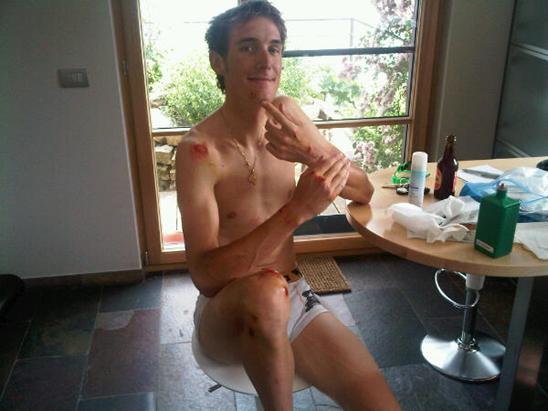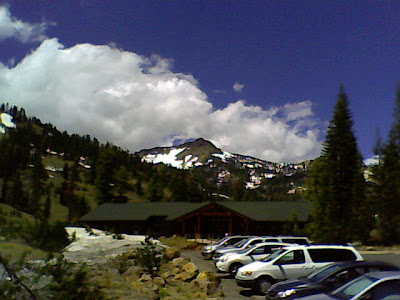
For Christmas this year I bought myself a Garmin 305 Forerunner, the latest element in my number-crunching approach to cycling. I wasn't always a number cruncher. For many years I just rode my bike--usually a 30-pound mountain bike--wherever the road or trail took me. Those were the years, back in the late 80s or 90s, when I made my first circuit of Trout Lake on a mountain bike. It was a 27-mile ride, and I thought I had nearly circumnavigated the globe. Now my ordinary ride is 31.2 miles. About that same time I started doing a few rides here in Hand Cove; it was a big accomplishment for me the first time I was able to ride up Cemetery Hill without stopping--or feeling that my hammering heart was going to immediately put me in the small hilltop cemetery. Now I cycle up that brute during every time trial.
I guess I didn't really get serious about cycling until the spring of 2002 when my son David began to hike the Appalachian Trail. This was also the year in which Lance Armstrong was being hyped to win his third consecutive Tour de France (equaling three-time winner Greg Lemond). It occurred to me that I could share both of these efforts vicariously by logging as many miles on my bike each week as David would be hiking. Of course, I wouldn't be wearing out my legs every day carrying a forty-pound backpack, sleeping on the hard ground, and eating freeze-dried food like David; nor would I be completing my 2,200 miles in 19 days of hard racing like Lance. Still, I would be logging the same number of miles, and the habit of writing down my miles on the calendar after each ride gradually turned into obsessive number-crunching.
By the end of that summer I was starting to record times and average speeds for my standard ride--at least when they were fast enough to be worth writing down. I bought my first serious road bike, an entry-level Giant OCR3, in September of 2002--and dutifully weighed it on my bathroom scale (24 pounds). To me, it was an amazingly beautiful and light bike, with its gleaming yellow paint job like the yellow jersey in the TDF. I still enjoy riding that bike and have now modified it into a touring/cyclocross rig.
I kept logging my miles and best time trials. In the spring of 2004 I retired from teaching, creating the opportunity for improved physical conditioning and more-obsessive number-crunching. In the fall of that year, as a retirement present, I bought myself the lightest production bike I could find--a Motobecane Le Champion SL, weighing a feathery 16.5 pounds! I was in number-crunching heaven and started to hammer out some very fast time trials. My calendars for those years are stored away at the moment, but I think it was in 2005 that I pegged my "personal record" at 18.2 MPH for the TT. That record stood until June 26, 2008, when I recorded a (for me) astonishing time of 1:41:46 -- or just over 18.5 MPH. Note that by this time I was recording my times to the nearest second!
Although 2009 was a very good year for me, the fastest rides I could manage came in at 1:43:14 and 1:43:46--about a minute and a half off the record--and they flattened me! I could hardly move when I got off my bike after those time trials. In 2010 I trained more diligently than ever. I had now moved on to recording my speed whenever I happened to average more than 16 MPH (a "good ride"); and whenever I averaged more than 17 MPH, I rewarded myself with a two-beer lunch. During 2010 I smashed my past achievements by recording fifty-seven "good rides" and enjoying eighteen two-beer lunches. Yet, in not one of these rides did I crack the daunting 18 MPH barrier! Well, at 62 what can one expect? One can't be a young man forever.
So the first time I strapped on my Garmin 305, I felt confident that I would collect a lot of interesting data--GPS mapping, average speed, max speed, elevation, percent grade, feet climbed and descended, heart rate, maximum heart rate, and average heart rate. All were of mild interest to me as a way of feeding my addiction to numbers, but my performance in January and February was pretty pathetic. I did manage a few 16 MPH rides, but that seemed to be pushing the limit of what I could do. I returned from them exhausted and without much hope of cracking 17 MPH -- let alone the impenetrable barrier of 18 MPH.
Still, by studying all the data recorded on my yearly calendars, I began to form a plan. I noticed that my fastest time trials came at the end of extended periods of diligent training, followed by one or two days of rest. For example, I biked every day from June 15th through June 24th of 2008, took one day off, and then ripped my TT at an average speed of 18.5. A couple of other hypotheses also emerged from the data. First, I did my best in spring and fall. Winter never allows the religious daily riding necessary to train for a TT; in contrast, summer temperatures inhibit performance because of the strength-sapping build-up of body heat. Second, I knew that my best performances came on calm days; the benefit of a tail-wind never quite equals the harm of a head-wind. And in the final stage of obsessive behavior, I became superstitious. A cup of coffee to jump-start my heart, a handful of mixed nuts for preride fuel, and a couple of fig newtons for a mid-ride sugar-rush became almost ritualistic requirements in a TT.
Then there was the Garmin factor. Most of what the device can do is put numbers to things I already knew. I knew my TT course was hilly; the Garmin measured half-a-mile of climbing. I knew that my legs started to burn and my lungs to burst if I pushed too hard at the very top of Woods Point Hill and Cemetery Hill. The Garmin told me that my heart-rate was hitting 155-160 beats per minute in those sections. (Maximum heart rate is age-related and can be measured by field tests or calculated by several formulas, the simplest of which is "220 minus your age". So in my case max heart rate should be about 158.) I knew that on a fast time-trial I felt drained at the end and on a recovery ride I felt re-energized. The Garmin told me that my average heart rate was over 140 (i.e., 90% of Max HR) in a fast TT and about 125 in a recovery ride (<80% of Max HR).
I had hoped that the Garmin might give me percent gradient for the hills, but GPS coordinates don't do a good job measuring vertical elevation. In total capitulation to number-crunching I drove over to Cemetery Hill and measured the grade using a long, straight board, a level, a tape measure, and a calculator. It turns out that nastiest, steepest part--right at the top of a long slog upward--hits 16%.
Perhaps more usefully, the Garmin can put numbers to some of the signs of improved conditioning that one feels "in the legs." For example, on January 27th I ground out a hard TT at 16.1 MPH with an AveHR of 140 BPM. Last week I took a "recovery ride" with an AveHR of 130 BPM and had an average speed of 16.5 MPH.
As a training tool, however, there was always just one reason why I bought the Garmin 305: inside that somewhat boxy wristwatch, the geniuses at Garmin have imprisoned a "virtual training partner," a tiny demon, a hyper-competitive cyclist who matches you peddle-stroke for peddle stroke--pacing you up the hills--indeed almost always beating you up those damnable hills--and swooping down the descents just in the lead. On a good day he is almost in reach. Sometimes he hangs out 500 feet ahead of you, sometimes only 18 feet ahead, and sometimes--on the rare, glorious day when you are really on form--the little devil falls steadily behind. (The photo used here shows a runner, but for cycling it shows a little man on a bike.)

That little demon is what helped me set my new personal record on April 12, 2011. In the middle of March I had put in a number of consecutive training days. In late March and early April I was coming into form with a series of good time trials: 3/28 a 16.7 MPH ride, then two rest days, 3/31 a 17.8 MPH ride followed by training rides on the next two days, then two rest days, 4/5 an 18.3 MPH ride (less than a minute away from the record!), 4/7 a 17.6 MPH ride, 4/9 a short training ride, and finally two rest days on 4/10-11. So on the morning of April 12th I thought that conditions could be ripe for a record. I set up the Garmin so that I was racing against my performance of April 5th and peddled hard out of the starting gate.
From past experience I knew that I can usually tell after the first four miles if I have a chance at a good TT, but by racing against myself on the Garmin I was getting continuous feedback. Unfortunately, the news was not comforting. I was losing; the little demon from the past was beating me again. But I wasn't losing by much and I was confronting a bit of a head-wind that would become a tail-wind at the Highway 412 turnabout. When I got to 412 for the first time, I was about 500 feet behind. What's that? Fifteen seconds at most. I knew the trick would be to go so fast on the downhill section to Woods Point that my tail-wind would become a virtual head-wind. I had actually pulled ahead of the demon before getting to the store and clobbered the little devil in the final miles to the landing. Sweet! I was winning. But then I turned into the head-wind again and started to climb out of the valley and my lead kept on dwindling. By the time I returned to 412 for the final turn, I was again behind, and my hopes of victory were fading. Once again, though, the turn gave me the tail-wind and the tail-wind eventually gave me the lead. So now the question was whether I could have enough of a lead by the top of Cemetery Hill that I would gain the minute I needed to set an all-time record. Of course, I did it--but the point is, I couldn't tell I would do it until the very end. My margin of victory amounted to two minutes and forty-seven seconds; so for about the last mile I knew that I "had it in the bag," but until then even the victory itself was in doubt.
I salute you, little demon. You were a valiant opponent and gracious in defeat.

On April 30th I put the Garmin to good use again, logging the route and elevation of the
Tour de Hills--more popularly and appropriately known as "The Jasper Disaster" because of its punishing hills. (I also like the logo on the free tee-shirts--"Gravity Always Wins.") This year the ride was especially challenging because at the top of the first long climb we found ourselves riding into a cold, steady drizzle. (We were actually in the clouds.) The drizzle stayed with us until the final descent to Harrison. Here is the profile for that ride:





















































